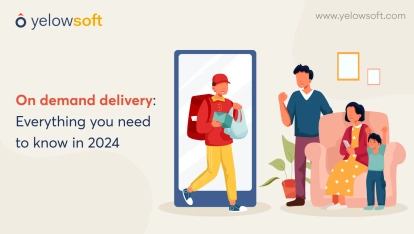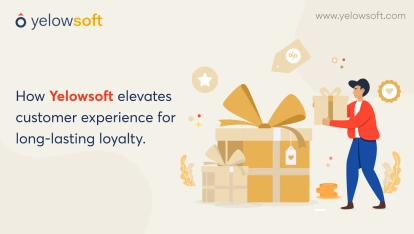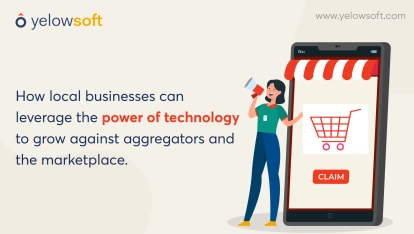Quick Summary
This guide is different from others that you see on the internet. It is a treasure trove of insights explained in a simple language by the experts. It covers everything from the basics of hyperlocal business to market research to operational strategies to technology which is the “delivery management system” you will need to start a successful business. By the end of this blog, you will master the process of starting your hyperlocal delivery business model and will guide others.
Curious about launching your own hyperlocal delivery business? You have come to the right place. And if you have decided to start this business, it means, you know what customers need today - convenience.
In today's fast-paced world, convenience is king, and consumers expect their goods and services to be delivered right to their doorstep. This growing demand for instant gratification has given rise to the hyperlocal delivery business model.
But to start a successful hyperlocal business, you will need in-depth information on launching it.
In this blog, you will explore the hyperlocal delivery business model, proven steps to start, the delivery management software you will need to manage it easily, how you can scale it and more.
Let’s start with the basics first. If you are aware of the basics, you can click here to learn the steps.
What is the hyperlocal delivery business model?
Let’s know this by splitting the “hyperlocal” word. Hyper means - extremely and local means local. In the context of the ‘hyperlocal delivery business model’ is a service that delivers goods within a small, specific geographic area.
In simple words, the hyperlocal delivery business model is a system to provide fast and efficient on-demand delivery within a limited radius to satisfy the needs of local customers.
This hyperlocal business can also be defined as an online on-demand delivery business model where the on-demand needs of customers are met by leveraging technology such as on-demand delivery apps or online ordering and delivery software.
If it still sounds confusing, here is an example for you.
The characters involved here are:
- Customer
- Aggregator
- Driver
Consider, you are running a hyperlocal delivery business in your area. One of your customers has forgotten his necessary document file at home and wants it on an urgent basis in the office. He uses your mobile app and requests a file pickup from his home.
You accept the request, assign the request to the driver, get him to pick up the file from home and deliver it to the customer-selected location within the locality. And in minutes, the customer gets his document. The complete process from requesting a pick to delivering successfully on time is a successful hyperlocal delivery business.
This is just a one-use case of the hyperlocal business. There could be many which you will discover below.
What services do hyperlocal delivery businesses include
Hyperlocal delivery businesses can include a wide range of services. From delivering groceries and meals to transporting packages. From running errands to providing on-demand services like laundry or pharmacy deliveries and more.
What needs does it cater?
A hyperlocal delivery business caters to the needs of customers in a specific neighborhood, small town, or a localized part of a city. You can offer lightning-fast delivery of products like food, groceries, or retail items and promise unmatched convenience and an exceptional customer experience.
Benefits of hyperlocal delivery business for you
| Benefits | Additional Advantages |
| Build better relationships with customers in the neighborhood. | Increase your profits by serving a loyal local customer base. |
| Save money on costs like transportation and fuel. | Boost your business revenue through repeat orders and word-of-mouth referrals. |
| Deliver orders quickly and keep customers happy. | Minimize your expenses by focusing on a smaller delivery area. |
| Stand out from big companies in your area. | Maximize efficiency with shorter delivery distances. |
| Get support from locals and boost your business seamlessly. | Expand your market share by dominating the local delivery market. |
| Change and adjust easily to what your customers want. | Enhance your brand reputation as the trusted choice for local deliveries. |
| Help the environment by not driving long distances. | Diversify income streams with potential for additional services or partnerships. |
| Improve your business cash flow with faster inventory turnover and payment cycles. | |
| Capitalize on seasonal trends and local events for sales growth. | |
| Achieve higher margins by offering premium or specialty delivery services. |
Understanding your target market

Before you get into the hyperlocal delivery business directly, you should first gain a deep understanding of the target market. A few steps you should take to get a proper understanding of the target market are below.
Conduct market research
To establish a successful hyperlocal delivery business, you must start by identifying your target geographic area. This could be a;
- Densely populated neighborhood
- A bustling city center or
- A small town with a tight-knit community
Once you've defined your target area, it's time to do a thorough market research. And for that, here is what you need to do.
Analyze consumer behavior and preferences within your chosen region and ask questions like:
- What types of products or services are in high demand for delivery?
- What are the peak hours and days when customers are most likely to place orders?
Understanding these nuances will help you tailor your offerings and operations accordingly.
Additionally, assess the competition in your target area. Check out if;
- Are there already established hyperlocal delivery services operating?
- If so, what are their strengths and weaknesses?
Identifying gaps in the market and finding ways to differentiate your business will be crucial for success.
Define your target customer segments
Within your chosen geographic area, you'll need to identify and cater to specific customer segments.
- Start by analyzing demographics such as age, income levels, and location density.
- Next, perform a Psychographics analysis that includes lifestyle, values, and interests.
- Finally, study their purchasing habits and delivery preferences.
Understanding these nuances will help you design a seamless customer experience tailored to their needs.
Steps to developing your hyperlocal delivery business model
Till now, you will have an in-depth understanding of your target market. You can now start shaping your hyperlocal delivery business model.
This involves choosing the right product offerings, crafting a compelling value proposition, and developing a pricing strategy that resonates with your customers. Let us understand each of these in detail below.
Choose your delivery offerings
The first step in developing your business model is to determine what products or services you'll offer for delivery.
- Will you focus on a specific category like food delivery from local restaurants or grocery delivery?
- Or will you provide a broader range of offerings that includes retail items or even services like dry cleaning or pet grooming?
When selecting your delivery offerings, consider the demand and profitability within your target market.
Create your value proposition
To stand out in the competitive hyperlocal delivery landscape, you need to craft a compelling value proposition that clearly communicates your unique selling points and competitive advantages.
Speed and convenience are table stakes to create your value proposition.
But what else can you offer to differentiate your business? Perhaps, your unique selling point could be offering unmatched personalization. Allow your customers to customize orders. Another USP could be local expertise and community focus.
Remember, our value proposition should also encompass your pricing strategies and revenue models.
Build your delivery infrastructure

With your business model in place, it's time to focus on building a robust delivery infrastructure that can support your operations and deliver on your value proposition.
This involves developing a user-friendly on-demand delivery system, optimizing logistics and last-mile delivery, and implementing efficient inventory management processes.
You will learn each of these in detail below.
Technology platform and mobile app
This is the age of on-demand services. Be it food, grocery, meat, or anything else, everyone using a mobile phone needs everything on-demand, instantly and at their convenient place.
Hence, a seamless and user-friendly online ordering and delivery management platform is essential for your hyperlocal delivery business. At its core, you'll need a robust mobile app or website that allows your customers to browse products, place orders, and track their deliveries in real time. For example:
- If your niche is food, you may need a specific food delivery app.
- If your niche is grocery, you may need an on-demand grocery delivery solution.
- If you have decided to deliver only milk, you will need a milk delivery software.
Based on your niche, you will have to prioritize features and functionalities at the time of developing delivery management software. This will enhance your customer experience.
However, you deserve a precious tip here. This tip will save you time, energy, and a massive amount of investment you will make in building on-demand delivery software.
When designing your technology solution from scratch, you will have to prioritize features and functionalities that enhance the customer experience, such as;
- Intuitive ordering interfaces
- Secure payment gateways
- Real-time order tracking
Additionally, you will also have to consider integrating with third-party services like payment gateway, mapping and navigation apps to streamline your delivery operations.
Moreover, you will also have to consider user experience and design. See if your platform is visually appealing, easy to navigate, and optimized for various devices and screen sizes. Know that, a confused interface can quickly turn customers away.
But the best part is that you can get all these inbuilt if you choose a ready-to-use white-label on-demand ordering and delivery management software.
Logistics and last-mile delivery
An efficient logistics and last-mile delivery system is the secret to your hyperlocal delivery business's success. Decide whether to build an in-house delivery fleet or partner with 3rd party logistics providers.
Regardless of your chosen approach, optimizing delivery routes and implementing real-time tracking will be critical for you to ensure timely and reliable deliveries. Leverage advanced algorithms and fleet management software to optimize routes based on factors like;
- Traffic patterns
- Order volumes
- And delivery windows
Additionally, be prepared to manage peak demand periods and consider implementing surge pricing strategies to balance supply and demand. This will not only ensure timely deliveries during busy times but also help you maintain profitability and operational efficiency.
Warehouse and inventory management
Depending on the nature of your offerings, you may need to implement robust warehouse and inventory management processes. Consider whether a centralized or decentralized fulfillment model works best for your business.
Implement inventory tracking systems and integrate them with your on-demand software solution to provide real-time visibility into stock levels and automate reordering processes.
Marketing and customer acquisition

Even with a robust delivery infrastructure in place, attracting and retaining customers is crucial for the success of your hyperlocal delivery business.
This involves building a strong local brand, leveraging digital marketing strategies, and implementing customer loyalty programs to foster long-term relationships. Below, you will get to know each of these in brief.
Branding and local positioning
When it comes to hyperlocal delivery business, building a strong local brand identity is paramount. Your brand should resonate with the community you serve and foster a sense of trust and familiarity.
Start by developing a distinct visual identity including;
- Memorable logo
- Color scheme
- Brand messaging that aligns with your value proposition.
Another powerful tool for your brand’s local positioning is building community engagement and partnerships. You can build awareness and goodwill of your business by participating in;
- Local events
- Sponsor community initiatives
- Other local businesses
Digital marketing strategies
While local branding is essential, you'll also need to leverage digital marketing strategies to reach and acquire customers in the digital age. Start by optimizing your website and online listings for local search engine optimization (SEO). Ensure that your business appears prominently when customers search for hyperlocal delivery services in your area.
Social media marketing and content creation should also be part of your digital strategy. Develop a robust social media presence on platforms like Facebook, Instagram, and TikTok.
Customer retention and loyalty programs
Acquiring new customers is important, but retaining existing ones is equally crucial for long-term success. Implement customer loyalty programs in your online ordering app or web booking platform that incentivize repeat business through rewards, discounts, or exclusive offers.
Continuously solicit customer feedback and use it to refine your offerings. By prioritizing customer retention and continuous improvement, you will build a loyal customer base that will fuel the growth of your hyperlocal delivery business.
Operational considerations

When you are done with all the above, you should look for operational considerations such as regulatory compliance, staffing, and risk management. These factors play a pivotal role in ensuring the smooth and sustainable operation of your hyperlocal delivery business.
Regulatory compliance and legal requirements
Depending on the products or services you offer, your hyperlocal delivery business may be subject to various regulations and legal requirements. For instance, if you're delivering medicines, you'll need to comply with medicine regulations. It may include obtaining necessary permits and licenses.
Consult with legal professionals to ensure your business practices are compliant and protect both your employees and customers.
Staffing and human resources
Your delivery personnel are the face of your business. They interact directly with your customers and represent your brand. As such, hiring and training the right individuals is crucial for maintaining a high level of service and customer satisfaction.
If you plan to employ full-time or part-time delivery staff, establish robust hiring processes, background checks, and comprehensive training programs to ensure they understand your brand values, delivery protocols, and customer service standards.
Consider offering competitive compensation packages, performance-based bonuses, and opportunities for growth and advancement to foster a motivated and engaged workforce.
Risk management and insurance
As with any business venture, managing risks and securing appropriate insurance coverage is essential for protecting your hyperlocal delivery operations. Liability coverage for deliveries and accidents should be a top priority. This will safeguard your business from potential legal and financial risks.
Additionally, develop a comprehensive business continuity and disaster recovery plan to ensure your operations can withstand and recover from unexpected events like natural disasters, power outages, or cyber-attacks.
Scaling and expanding your business

As your hyperlocal delivery business gains traction and establishes a loyal customer base, you may consider scaling and expanding your operations. This presents new growth opportunities. And also introduces additional complexities and challenges that must be navigated strategically.
Growth strategies and expansion plans
Carefully evaluate the demand, competition, and operational feasibility of each new market before committing resources.
Diversifying your product offerings and verticals can also open up new revenue streams and attract a broader customer base.
For example, if you started with food delivery, you could explore adding grocery, retail, or even service-based offerings to your platform.
Conclusion
Building a successful hyperlocal delivery business model requires a strategic blend of market research, operational excellence, and a customer-centric mindset. By following the steps discussed in the guide, you'll be well-equipped to navigate the challenges and capitalize on the immense potential of this growing industry.
Remember, success in the hyperlocal delivery business relies on two factors.
One - your ability to provide unparalleled convenience, speed, and personalized service to your customers.
And second, is using reliable white-label software for managing your hyperlocal delivery business seamlessly.
If you are looking to get everything in one place to start your successful hyperlocal delivery business, feel free to reach out to our expert. And if you just need a technology solution, then look for ready-to-use ordering and delivery management software - based on your business category and needs from Yelowsoft.

FAQ's
A hyperlocal delivery business model focuses on serving customers within a very specific geographical area, such as a neighborhood or city block. It involves delivering goods and services quickly to meet the immediate needs of local customers.
Hyperlocal delivery is important because it offers several benefits. This includes faster delivery times, stronger customer relationships, lower operational costs, and reduced environmental impact.
In a hyperlocal marketplace, local businesses and service providers list their products or services on an online platform. Customers can then browse and purchase items from nearby stores, with orders fulfilled through quick and efficient local delivery.
Hyperlocal marketplaces typically utilize mobile apps, online ordering and delivery management platforms or websites for ordering, real-time tracking systems for deliveries, and geolocation technology to match customers with nearby businesses.
Hyperlocal businesses often adopt decentralized supply chain models. Here goods are sourced locally and delivered directly to customers without the need for extensive warehousing or transportation networks.
In a hyperlocal delivery model, orders are received from customers through an online platform. Local delivery personnel, such as couriers or drivers, then pick up the items from nearby stores or the place the customer asks for and deliver them directly to the customer's location on time.
Some benefits of creating a hyperlocal business model marketplace include faster delivery times, reduced operational costs, stronger community connections, and the ability to offer personalized service to local customers.
The future of hyperlocal marketplaces looks promising. With continued growth driven by consumer demand for convenience, personalized service, and sustainability. As technology advances and consumer preferences evolve, hyperlocal businesses will likely play an increasingly important role in the retail landscape.



